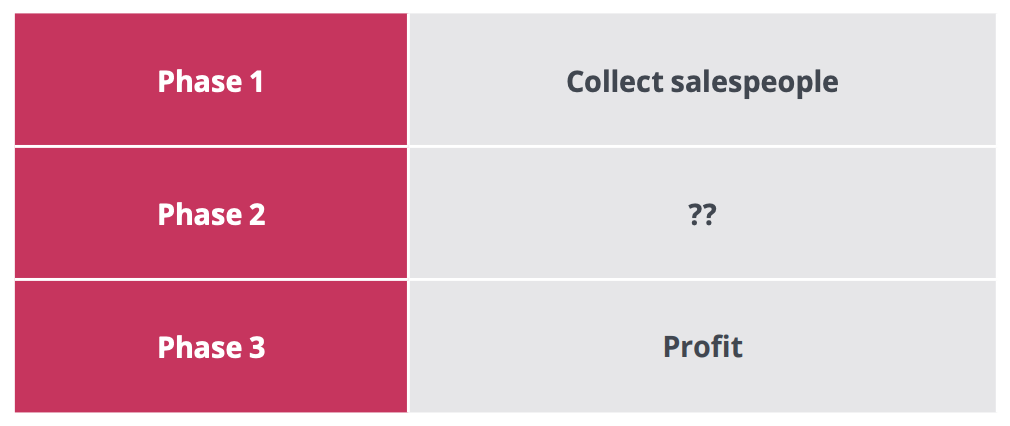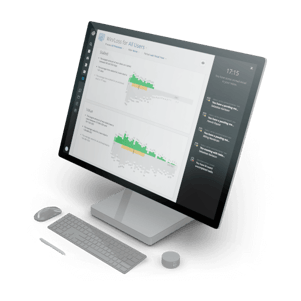A FRAMEWORK FOR MANAGING AND COACHING A TOP PERFORMING B2B SALES TEAM
In an episode of the popular, irreverent cartoon South Park, the main characters visit a factory run by gnomes.
The gnomes are stockpiling stolen underwear. One of the main characters asks a gnome: “So, what are you going to do with all of these underpants?”
The gnome responds: “Collecting underpants is just phase one.”
The first character says: “So, what’s phase two?”
The gnome pauses for a moment. Stands still, staring silently. He looks stumped.
He asks another gnome: “What’s phase two?”
The other gnome repeats that phase one is: “collect underpants.”
“Yes, but what’s phase two?”
He responds: “I don’t know.”
There’s even a chart demonstrating the plan, with a giant question mark under “phase 2.”
Of course, this is a laughable business plan, and it’s intended to be. Unfortunately, many sales organizations operate exactly like the gnome’s secret stolen underwear stockpiling facility.

While arguably a salesperson may be a better investment than stolen underpants, nevertheless the fact remains that most sales organizations lack clear visibility into what happens between when a salesperson is hired and when they start churning out a profit.
You may know a few key facts, such as win rates, quota attainment, and sales cycle length, but even those data points are usually murky and ill-defined, and they fail to give organizations the kind of insights they need to effectively drive improvement.
In fact, in most cases, organizations continue to limp along with bloated pipelines, missed forecasts, and unpredictable quarter by quarter performance, unable or unwilling to make the changes necessary to gain control over their profits.

When CRMs were originally introduced, they were supposed to be a silver bullet for this problem, providing a new level of transparency into the workings of the sales team. But it hasn’t turned out that way.
Salespeople may or may not log all their activities, and even when they do, traditional CRM reports only provide managers with insight into how many and what activities are engaged in, not whether those activities were effective, whether they moved the sale closer to the close, or how likely the sale is to move forward.
Even with call recording technology, managers and executives have no consistent way to measure the effectiveness of specific activities and behaviors across the sales cycle, or to compare the success rate of prospects by industry, size, competitors being considered, or other potentially critical factors.
In order to remove those giant question marks and replace them with actionable insights that drive continuous performance growth, organizations need to adopt a more scientific approach to collecting, managing, and analyzing their data to inform coaching and management efforts and drive higher performance.
In this paper, we present such a framework - one that yields dynamic, detailed, useful data and analytics and gives you the tools you need to coach more effectively, get more out of your enablement efforts, and drive continuous improvement on your sales teams. Even if your giant question marks are already smaller and fewer than other organizations’, this framework will help you fine-tune what’s working and add a structure that gives you more actionable insight and fewer question marks.
If you implement the principles and steps in this guide, you’ll enjoy greater transparency into pipelines, more reliable forecasts, improved sales effectiveness and overall better results.
CHAPTER 1
While many organizations talk the talk when it comes to sales analytics, very few effectively leverage them to improve sales effectiveness and deliver better results. Historically, good analytics have been difficult to come by, for many reasons, and the sales team’s reluctance to record data certainly doesn’t help.
If you want to drive performance with analytics, you must first prevent the most common mistakes. Here are the top three:
At the end of last quarter, how many of your salespeople had made their quotas? You can probably cite this number off the top of your head.
Likewise, each of your salespeople is acutely aware of their quota number and how they’re measuring up to it. In fact, there’s a good chance that this data point keeps them awake at night.
You may be using this number for a variety of purposes: To issue compensation, award department honors, and assign bragging rights. You may use it in hiring and firing decisions, and to determine who needs more coaching and training.
In fact, it’s possible that quota attainment, along with win rates and sales cycle lengths, are your primary management tools, and that you think of this as “managing by the numbers.” And that’s a problem.
Quota attainment, win rates, and sales cycle length are useful indicators, but they are lagging indicators. There are also a number of issues in how win-rates and sales cycles are measured that add to this problem.
Using these metrics to manage a team is like driving a car while staring in the rear view mirror. You learn a lot about where you’ve been, but not much about how to get where you want to go.
“Managing by the numbers” in this way causes a host of problems on the sales team, including:
If you’re seeing these problems, you’re not alone. The proactive analytics you need in order to escape this cycle have not traditionally been easy to come by. Fortunately, the tools and frameworks for managing proactively are here now, and we’ll be exploring them in the second half of this paper.
Perhaps you’ve been reading the previous section and thinking, “Not us! We measure activities too, which are a leading indicator.”
Pat yourself on the back, but maybe not too hard.
Activities can be leading indicators and are important to measure, track, and manage. They are a critical part of any effective, proactive analytics and management system.
But many organizations measure activities in a vacuum, devoid of crucial context. You may know how many cold calls a salesperson has made that week, how many meetings they scheduled, and whether they followed up on all their “live” leads.
This is helpful information for course-correcting when a salesperson isn’t doing their job. But what if the salesperson is doing all of their activities, but their performance still lags? Identifying and addressing the problem then becomes far more difficult.
A more effective approach is to track activities and information in the context of progress. This requires that you collect data in the context of a clear and consistent process, with stages, milestones, and steps, and that each sale is tracked through the process.
This information helps managers understand where a salesperson may be struggling, and provide the right coaching and enablement to improve their ability to move sales through the process.
Tracking activities in the context of progress also help you quickly see when a deal may be lagging, making it possible to intervene before the sale goes sour.
Finally, tracking activities and information in context helps managers to understand which behaviors, activities, and situations are effective and when so that they can continuously improve the process and their coaching for the best possible outcomes.
You know this scenario. It’s time for reports. The sales manager generates one out of the system, a quick task. But then, the data has to be massaged.
This isn’t always a defensive gesture on the part of the manager. It’s a necessary process because they know that the numbers coming out of the system aren’t going to provide an accurate view. Only they have the required insight to make the reports reflect reality.
They know which salesperson’s pipeline is bloated because they’re consistently overly optimistic. They know which salespeople have a habit of coming through at the last minute with deals that they don’t enter into the pipeline until right before close. They know which salespeople enter every contact as an opportunity, and which ones only enter an opportunity when they’re confident the deal will close.
Over time, a lot of managers become quite good at this task. In those cases, the forecasts and reports can be a reasonable indicator of current and expected performance.
But even in a best-case scenario, the task is time-consuming. The process is subjective and prone to error. And some managers are better at it than others.
It also means that you have no reliable way to glean clean data and analytics from your system because large portions of your organizational knowledge is locked inside the heads of managers and salespeople.

CHAPTER 2
Sales analytics alone won’t save your sales organization. But without reliable analytics, you’ll be some-what blind, severely less effective, and lose competitiveness over time. But “data-driven” doesn’t always equal “effective.”
Here’s how to establish analytics across your organization that enables effective, proactive sales management.
You know how important it is to build a house on a solid foundation. Set it on a bad foundation, and it won’t matter how beautiful or elegant your home is… it will crumble away before you have time to enjoy it.
But on the right foundation, you can build the home of your dreams in confidence that it will be around for a very long time. When it comes to your organization’s success, good data is a solid foundation, while messy, incomplete, and junk data is like shifting sands. Your organization’s data is the foundation of your analytics. And, if you’re like most organizations, that data is simply not solid enough. The root causes of garbage data are many and various, but they include:
You can stick a fancy analytics engine on top of a hot mess of data and try to build something out of it, but the result is unlikely to be inspiring… and very likely to be uselessly skewed.
Most organizations collect data on the number and type of activities their salespeople engage in, as well as general information about prospects, but without consistent criteria and a process-based system, this information is useless.
Start with your sales strategy, and design process that enables salespeople to execute effectively on it. You may need multiple processes depending on the type of engagement and type of sales workflow (prospecting, opportunity management, account growth planning).
The key is to articulate it clearly and establish key criteria for each stage of the process. And not to confuse prospecting with opportunity management, or account growth planning.
As an example, to deliver clear opportunity pipeline data, your process should be divided into subsections including:
For every stage, milestone, and step of the process, establish clear criteria that apply to every salesperson and every prospect engaging in that process. And ensure that you align milestones with what your buyers need to accomplish.
This helps ensure that you compare apples to apples when you look at your data. Every process will be unique, but most should at minimum establish criteria for:

For each team and team member to understand their progress, they need to see their goals and how they are doing. This feedback loop is crucial but not always transparent, or in real-time. Well-defined goals help people focus their attention, and give them something concrete to strive for.
Most sales teams are good at setting revenue goals, but in order to be more effective, it’s important to break goals down into milestones and actions that can be achieved along the way and to track progress against those milestones and actions.
Make your goal-tracking process transparent and, better yet, set it up so that tracking can be viewed in real-time. When salespeople have their goals and visual evidence of their progress in front of them at all times, they become more motivated to hit the next step or the next milestone in their progress.
Trendlines represent the “time” element of the sales process and are the most often missing element of sales analytics.
You need to know things like whether an individual salesperson is improving over time and how their improvement over time compares to their goals, their peers, as well as whether certain competitors are creeping up on you or the industry is gaining (or losing) traction.
Establish your system so that it gathers data over time and maintains trendline data for comparison and analysis and helps sales managers to identify who to coach, about what, and when.

On a solid foundation of clean, clear, useful data, you can build analytics that arms your managers and coaches with actionable insights. You want them to be able to see both leading and lagging indicators, compare salespeople to each other and to the average, compare industries, and view trendlines
A simple, beautiful dashboard should be able to provide them with key metrics at a glance while allowing them to actively “drill down” for deeper information. This will allow coaches to quickly see problems and then drill down to find the causes of those problems.
As an example, a common problem salespeople exhibit is the “roller coaster effect”–sales performance that has peaks and valleys.
The right analytics framework will allow managers to quickly understand why the roller coaster is happening.
For instance, it may be that the salesperson is not engaging in prospecting activities while delivering on sales, that they’re losing more deals than their peers late in the process, or that they’re spending too much time on smaller deals, leaving too little time to develop their pipeline while closing a large number of small deals.
By identifying the true cause, your coaches can focus on the right skills and activities to dramatically improve each salesperson’s performance. Granular analytics like this also allows you to measure the outcomes of specific behaviors and activities in a more general sense so that coaching can focus on the things that actually move the needle.
Most sales organizations give lip service to win/loss analysis, but few use it to drive continuous improvement. With clean data and granular analytics, win/loss analysis can be so much more than a finger-pointing exercise.
You can use the data to compare opportunities across time and understand the factors that influence the likelihood of winning and losing. This information can be iterated back into qualification criteria to help you improve which opportunities your salespeople focus their energy on.
You can also use analytics to:
Choose technology that sits at the center of your team’s workflow and guides them through your process and methodology in a beautiful, easy-to-use manner, and that provides them with enough value that they want to input their data.
It should also:
There are hundreds of CRM and sales enablement tools on the market today. It pays to take the time to find the one that will enable your organization to manage and coach your teams to top performance.

In summary, in order to make the most of your numbers, you need a metrics engine that makes it possible to:
When you manage effectively by the numbers, your team’s performance will improve consistently. You’ll:
Effective data analytics are critical to ongoing sales success in today’s sales environment.
From north to south, east to west, Membrain has thousands of happy clients all over the world.



